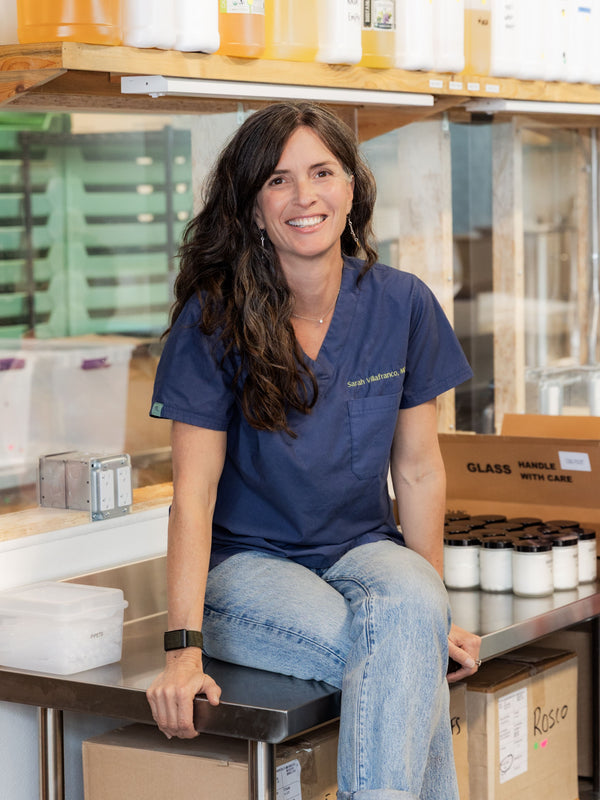 This post was written by the amazing Dawn Rains, who helps manage our garden and our beautiful compost pile! Dawn is a certified biodynamic gardener, and loves nothing more than a handful of rich earth and a carrot plucked from the ground. Thanks, Dawn, for making our organic lavender plants flourish, helping our zucchini grow to the size of small cars, and keeping our bees and butterflies incredibly happy! Read on for Dawn's tips on how to start a compost pile—fall is the best time to get it going! This guide is most helpful for those who have at least a small backyard, but if you're an apartment dweller, you still have options! You can join a community garden and contribute to the community compost pile by saving up your kitchen scraps in a bucket. And many cities have municipal composting options with curbside collection, so be sure to check with your local waste management company! One last tip from me before we move on to Dawn's instructions: you don't need a fancy bucket with a carbon filter—a simple stainless bucket with a lid works just fine!
This post was written by the amazing Dawn Rains, who helps manage our garden and our beautiful compost pile! Dawn is a certified biodynamic gardener, and loves nothing more than a handful of rich earth and a carrot plucked from the ground. Thanks, Dawn, for making our organic lavender plants flourish, helping our zucchini grow to the size of small cars, and keeping our bees and butterflies incredibly happy! Read on for Dawn's tips on how to start a compost pile—fall is the best time to get it going! This guide is most helpful for those who have at least a small backyard, but if you're an apartment dweller, you still have options! You can join a community garden and contribute to the community compost pile by saving up your kitchen scraps in a bucket. And many cities have municipal composting options with curbside collection, so be sure to check with your local waste management company! One last tip from me before we move on to Dawn's instructions: you don't need a fancy bucket with a carbon filter—a simple stainless bucket with a lid works just fine!
How To Start a Compost Pile
by Dawn Rains
Compost is life. When applied to vegetable gardens, fruit trees, and perennials, compost enlivens the soil and creates optimum growing conditions. Essentially, the act of composting is the decomposition of organic materials. Compost itself is the finished, soil-like humus, rich in good microscopic bacteria and fungi. Fortunately for your adventure in making a home-made organic compost, you only need a few things to get started.
#1 - WHAT CAN I COMPOST?
Organic materials! These are your vegetable scraps from the kitchen, lawn trimmings, leaves raked up in fall and garden trimmings. Ask a neighbor for all of their scraps also! Remember that composting these materials keeps them out of the landfill and repurposed back into your land.
#2 - WHERE SHOULD I COMPOST?
Maybe you have an unused corner in the back yard or garden—a lonely patch of grass. Go ahead and dig it out! As the composting process is happening and these materials are breaking down, contact with the earth will invite the earthworms into the pile. They are welcomed guests and will help by eating and digesting, leaving behind their "castings", a natural organic plant fertilizer.
#3 - WHAT TOOLS DO I NEED TO COMPOST?
A shovel or pitchfork! You'll need this to assist you in moving your collected plant materials. I find that the "three-pile" system is the most effective for home composters. If you like to have your garden and yard areas tidy, consider building some simple wooden bins. The bins should be made 3-4 feet square, side by side, with removable front panels (for easy access to the contents). Use a thick wood (like a 2x4") so the boards don't break down with the compost. The composting process requires plenty of air so the pile doesn't become stagnant and putrid, so make sure to leave gaps in the bin walls for air to get to the pile. Although having bins is unnecessary, keeping the piles somewhat contained (especially if you're short on space) is really nice.
#4 - HOW DO I COMPOST?
 Pile #1
Pile #1
The first pile is for the plant materials as you collect them. Your kitchen compost container can be emptied into this pile. Your neighbor's lawnmower bag. Raked leaves. This pile is simply a gathering place. It can take a long time to build up, as you might guess. I usually add to this pile through spring, summer and early fall. If you're interested in keeping the aroma down, place dry materials on top of kitchen additions. Be sure not to compost meat or dairy, and cut hard fruit and vegetable skins in to smaller pieces to help them break down more quickly.
Pile #2
Compost needs to be turned and the fresh material layered with dried out crunchy material. This is where the second pile comes in. In the fall, use the pitchfork or shovel to move the first pile into the second pile, shaking out those packed layers of grass and leaves, mixing it with what's left of the kitchen and garden trimmings. Also layer in a bit of soil. Add plenty of water as you stack it so that the pile is evenly moist.
Congratulations! You have officially "built" your first compost pile. The first pile is empty and ready for the collection to begin again. The second pile is full and actively breaking down.
Pile #3
The third pile is for the ambitious composter. Because compost needs moisture and air to break down faster and more effectively, the second pile can again be turned over into the third pile in the spring for one more synthesis. (Yahoo!) Once again, be sure to add plenty of water and rotate those crunchy outer layers of the pile into the soft, loamy soil-like compost that is beginning to form.
In about 1-2 months after this move to the third pile, one can start some exploratory digging, searching for finished compost. The finest compost will be in the middle of the pile. At this point, you can sift off compost to be used in the garden or as side dressings for trees. A simple sifter can be made out of a wooden frame with 1/2" hardware cloth stapled to it, set on top of a wheelbarrow or bucket. Everything that doesn't go through the sifter is held in the second pile for layering into the next pile that you build in the fall. Whew! It sounds complicated and time-consuming, but nature is really doing most of the work during those long intervals when the pile is just sitting. A few solid days in the garden from you each season is all it needs.
There are many ways to work with your pile- controlling the carbon/nitrogen ratio and how much water it gets, buying a really long thermometer to measure the temperature deep inside the pile, spraying between the layers with microbe inoculants, layering with cow manure, adding biodynamic preparations to build the etheric body of the pile and connect it to the cosmos, etc. OR, you could also just throw a bunch of stuff in a pile and hope.
I hope this guide gives you a great place to start collecting and reusing all of the amazing plant material that you may not have even noticed around you! The results are quite amazing when you're feeding the plants and trees on your land and nurturing the soil, as you nurture yourself.
Happy composting!

 This post was written by the amazing Dawn Rains, who helps manage our garden and our beautiful compost pile! Dawn is a certified biodynamic gardener, and loves nothing more than a handful of rich earth and a carrot plucked from the ground. Thanks, Dawn, for making our organic lavender plants flourish, helping our zucchini grow to the size of small cars, and keeping our bees and butterflies incredibly happy! Read on for Dawn's tips on how to start a compost pile—fall is the best time to get it going! This guide is most helpful for those who have at least a small backyard, but if you're an apartment dweller, you still have options! You can join a community garden and contribute to the community compost pile by saving up your kitchen scraps in a bucket. And many cities have municipal composting options with curbside collection, so be sure to check with your local waste management company! One last tip from me before we move on to Dawn's instructions: you don't need a fancy bucket with a carbon filter—a simple stainless bucket with a lid works just fine!
This post was written by the amazing Dawn Rains, who helps manage our garden and our beautiful compost pile! Dawn is a certified biodynamic gardener, and loves nothing more than a handful of rich earth and a carrot plucked from the ground. Thanks, Dawn, for making our organic lavender plants flourish, helping our zucchini grow to the size of small cars, and keeping our bees and butterflies incredibly happy! Read on for Dawn's tips on how to start a compost pile—fall is the best time to get it going! This guide is most helpful for those who have at least a small backyard, but if you're an apartment dweller, you still have options! You can join a community garden and contribute to the community compost pile by saving up your kitchen scraps in a bucket. And many cities have municipal composting options with curbside collection, so be sure to check with your local waste management company! One last tip from me before we move on to Dawn's instructions: you don't need a fancy bucket with a carbon filter—a simple stainless bucket with a lid works just fine!









